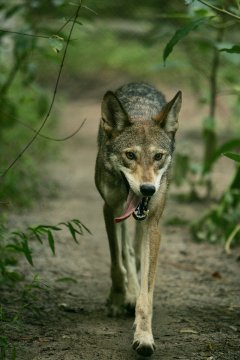Red Wolf

Geography and Habitat
The red wolf was once found in the southeastern part of the United States as far west as Texas and possibly as far north as southern Canada. However, predator extermination programs and loss of habitat resulted in the eventual functional extinction of the red wolf in the wild.
Reintroduced to the wild in 1985 in northeastern North Carolina, the red wolf’s range is now restricted only to that region. Efforts are being made, however, to return the red wolf to other areas of its historical range in the mountains, wetlands, and forests of the East and Mid-Atlantic.
Description
Red wolves are smaller and leaner than grey wolves and have shorter fur, longer ears, and longer legs. They are usually between three and four feet long and stand about two to two and a half feet high at the shoulder. The males are slightly larger than the females.
Though their backs are black and the tails are tipped with black fur, the coat of the red wolf is an attractive mix of gray and reddish brown. The backs of their ears and legs are often splashed with a reddish hue. Their coat is shed during the summer.
Reproduction
Like other wolves, the breeding pair is usually the only wolves to reproduce in the pack, with the father and other pack members helping to raise the cubs and provide food for the mother while she is lactating. Often, the other pack members are the children of the breeding pair from previous years. Wolves breed between January and March and pregnancy last about 63 days. The mother can give birth to one pup or up to 12, though the average litter is about five.
Behavior and Lifestyle
Red wolves prefer to hunt at night and the packs cooperate in hunting. The packs hold territories and can become aggressive toward any wolf that strays into it. Dens are dug out to raise the pups and can be found by the banks of streams or in hollow trees. Wolf packs are constantly in search of food for themselves and for their pups during denning season.
Besides humans, red wolves are killed by other wolves, and pups can also be taken by birds of prey, alligators, and bobcats.
Besides howls and other vocalizations, red wolves communicate with each other through touch, smell, sight and body language. They scent mark the boundaries of their territory with their urine.
Diet
Red wolves are carnivores. They depend on meat to live and reproduce. The diet of red wolves is dominated by white-tailed deer as well as small mammals like rodents, rabbits, and raccoons. They occasionally eat fruit and will scavenge for road kill.
Lifespan
Most red wolves in the wild live to be only about four years old, though some survive into their teens. In captivity, the average lifespan for a red wolf is about 14 years at the high end.
